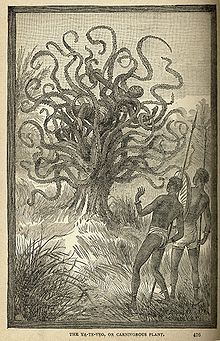- Cryptobotany
-
 Depiction of a man-eating tree from Central America.
Depiction of a man-eating tree from Central America.
Cryptobotany is the study of various exotic plants which are not believed to exist by the scientific community, but which exist in myth, literature or unsubstantiated reports. Folk legend and ethnic usage of plants, often as interdisciplinary research, is presented and developed for an unknown species, in the hope of allowing those species to be collected or adequately identified. Any researcher or writer can identify himself or herself as a cryptobotanist; the field is surveyed within cryptozoological or other journals, or with varying degrees of skepticism as a protoscience.[1]
Many plants remain undiscovered or are yet to be classified, however cryptobotany usually focuses on fantastical plants believed to have harmful or therapeutic interactions with people. Sources of data may be secondary or scant; reports may be plausible or outlandish.[2]
Man eating plants, most frequently inhabiting the jungles of Africa in popular fiction, may have been based[citation needed] on initial reports of plants that could trap and kill mammals, such as Nepenthes rajah.[3] However, there are unconfirmed reports, primarily from Latin America, that allege the existence of still-undiscovered species of large carnivorous plants, according to British cryptozoologist Karl Shuker's book The Beasts That Hide From Man (2003).[4]
See also
Notes
- ^ Roesch, Ben S. (1999). "Taking a Hard Look at Cryptozoology: A Critical Approach to Cryptozoology". Author's On-Line Cryptozoology Archives. http://web.ncf.ca/bz050/criticalcz.html. Retrieved 2007-07-03. "Thus the argument goes: in order to ensure accuracy in cryptozoology, research on sasquatch should be done by a primatologist or physical anthropologist, and research on sea serpents should be done by a marine biologist, preferably one who has good knowledge of both invertebrate and vertebrate marine organisms."
- ^ Paul McCarthy (1993-01-11). "Cryptozoologists: An Endangered Species". The Scientist, Vol:7, #1 ). http://web.ncf.ca/bz050/HomePage.scza.html. Retrieved 2007-07-03. "Krantz is a member of a small band of scientists called cryptozoologists, who stalk previously undescribed--and, some would say, nonexistent--animals. This includes new species of lizards, monkeys, and other ho-hum creatures, but also beasts of mythic proportion: ..."
- ^ Phillipps, A. 1988. A second record of rats as prey in Nepenthes rajah.PDF (203 KiB) Carnivorous Plant Newsletter 17(2): 55.
- ^ Shuker, Karl P N (2003). The Beasts That Hide From Man. Paraview. ISBN 1-931044-64-3.
Bibliography
- Terence McKenna, 1992 - Food of the Gods: The Search for the Original Tree of Knowledge - A Radical History of Plants, Drugs, and Human Evolution (Bantam) ISBN 0-553-37130-4
Categories:
Wikimedia Foundation. 2010.
